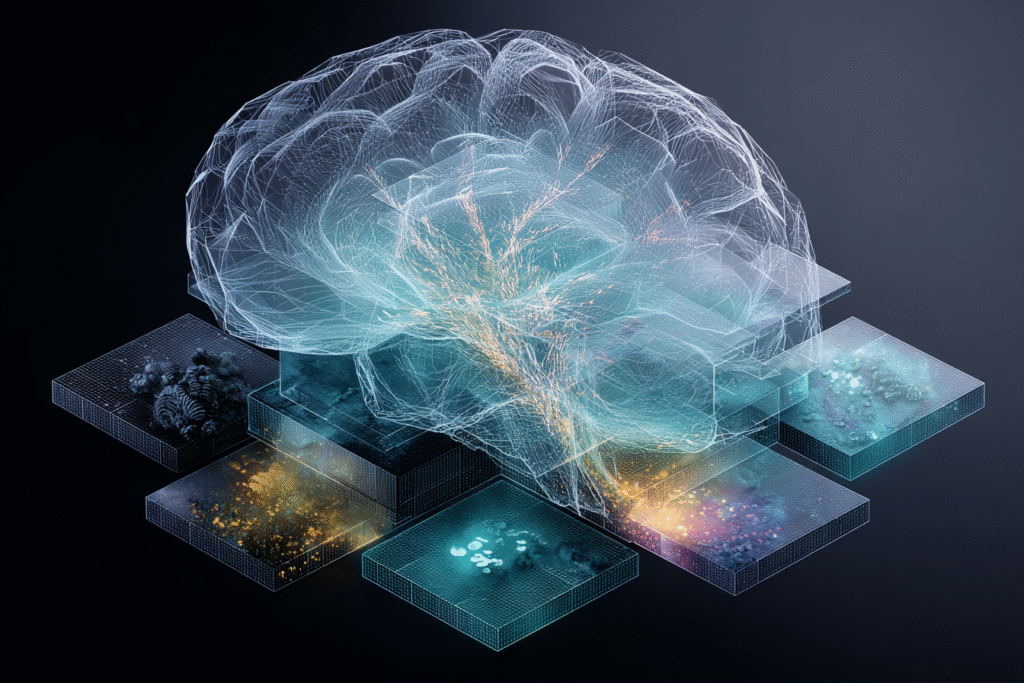Right now, as you read this, powerful systems in your brain are deciding what exists in your reality—and what doesn’t.
Yesterday, we explored how CNNs learn to filter reality through layers of abstraction—each layer detecting edges, patterns, and features that matter for the task at hand. But here’s what’s remarkable: long before we taught machines to see, evolution gave you something far more sophisticated and far more personal.
After 15 years developing and working with AI systems, I’ve learned that your brain doesn’t just filter information like a CNN. It filters your entire reality based on what it believes will keep you alive, help you belong, and match what you’ve experienced before. The difference? You can’t see your own code running.
Every moment, your nervous system is bombarded with over 11 million bits of sensory data. Yet your conscious mind can process… maybe 50.
The question isn’t what’s real.
It’s: what gets through?
Your mind isn’t an open window — it’s a filter. And before you have a single thought, a powerful network in your brain has already decided what to show you… and what to leave out.
The RAS: Your Inner Gatekeeper
The Reticular Activating System (RAS) is a network of neurons spanning your medulla, pons, and midbrain—essentially the evolutionary command center that’s been keeping humans alive for millions of years. This isn’t just a simple filter; it’s a sophisticated arousal and attention system that integrates sensory input, emotional significance, and survival priorities in real-time.
Think of it as your brain’s executive bouncer—but one that operates on neurochemical intelligence. Your RAS runs on neurotransmitters like norepinephrine for alertness, dopamine for reward-seeking, and acetylcholine for focused attention. When these systems fire together, they don’t just decide what you notice—they literally change your state of consciousness to match what your brain believes you need to see.
Its primary job? Keep you alive. Which means its filtering criteria aren’t optimized for clarity or truth—they’re optimized for survival, familiarity, and emotional salience.

Ever notice how the moment you decide to buy a red car, you suddenly start seeing red cars everywhere? That’s your RAS updating its priority matrix. It didn’t change the world—it just recalibrated what deserves conscious attention. The same thing happens when you start thinking about having kids and suddenly notice strollers everywhere, or when you’re worried about money and every conversation seems to mention financial stress.
But here’s what’s remarkable: your RAS operates differently depending on your internal state. When you’re stressed or anxious, it sharpens its focus on potential threats—that person’s tone, that unexpected email, that slight change in routine. When you’re calm and focused, it opens up to possibilities—creative solutions, opportunities, connections you might have missed.
This system doesn’t just control what you notice in the outside world. It also decides which internal thoughts, memories, or insights rise to the surface—and which ones stay buried in the background hum of your subconscious. And it’s always working. Not thoughtfully. Not wisely. But efficiently—according to the programming it’s received through repetition, intensity, and emotional imprinting.
The Thalamus: Your Reality's Relay Station
But the RAS doesn’t work alone. Meet your thalamus—the relay station that sits between raw sensory data and conscious awareness, quietly orchestrating what becomes your experience of reality.
The breakthrough insight from neuroscience research is that consciousness isn’t about processing more information—it’s about processing the right information at the right time.
Every second, your nervous system processes over 11 million bits of sensory data, but only about 50 bits make it to conscious awareness. Before any of that sensory information becomes conscious experience, it must pass through your thalamus—a walnut-sized structure that acts as the brain’s central switching hub and manages this massive filtering operation.

The thalamus doesn’t just passively relay information. It actively sorts, prioritizes, and routes signals based on instructions from your RAS about what matters right now.
This is why you can be in a crowded restaurant with dozens of conversations happening simultaneously, but the moment someone across the room says your name, it cuts through everything else like a spotlight. Your thalamus, guided by RAS priorities, literally routes that signal differently than background chatter. The acoustic information was always there—but your thalamus decided it was worth conscious attention.
Together, your RAS and thalamus create what neuroscientists call “selective attention”—but what you experience as reality itself. Your RAS sets the priorities based on survival needs, emotional significance, and learned patterns. Your thalamus executes those priorities by controlling which sensory streams reach your cortex with full intensity and which get filtered down to background hum.
You’re not seeing what’s there. You’re seeing what your ancient survival systems, combined with your learned patterns, have decided is worth your conscious attention. And that’s exactly where the opportunity for clarity begins.
When I Discovered My Hidden Filter
I was walking through a grocery store last month when I noticed something strange: I kept seeing the same brands over and over, as if the store only carried three types of everything.
Then I realized what was happening.
I’d been intermittent fasting for six weeks, and my RAS had become laser-focused on “healthy” food signals. My brain was literally filtering out entire aisles—the chips, the cookies, the processed foods. They weren’t invisible, but they might as well have been. My attention slid right past them.
When I consciously forced myself to look at the “forbidden” aisles, it was like putting on glasses for the first time. Hundreds of products I hadn’t noticed in weeks suddenly appeared. The store hadn’t changed—my filters had.
That’s when it hit me: if my brain could make food disappear without my permission, what else was it editing out of my reality?
Trauma, Conditioning, and the Filters You Didn’t Choose
The filters that shape your perception didn’t come with a manual. Most were installed without your consent — through repetition, emotional impact, and survival-level learning. The Reticular Activating System doesn’t wait for conscious permission. It listens to pattern and intensity.

If something hurt you once, it flags anything similar as dangerous — even if it no longer is.
If you grew up with an unpredictable parent, your RAS might flag any slight change in someone’s tone as ‘danger’—even in a loving relationship 20 years later.
This happens because early experiences literally program your neurochemical sensitivity. If your childhood required constant vigilance, your brain developed a hair-trigger for norepinephrine and cortisol release. What felt like survival then becomes chronic anxiety now—your system firing stress chemicals at threats that no longer exist.
When trauma rewrites your filters, it’s literally changing the neurochemical thresholds for what triggers these attention systems. A single traumatic event can reset your norepinephrine sensitivity—meaning your brain becomes hypervigilant to similar patterns, flooding your system with stress chemicals at the slightest resemblance to past danger.
If something was repeated often enough — a belief, a phrase, a fear — it got logged as important.
The child who heard ‘money doesn’t grow on trees’ a thousand times develops an RAS that flags every expense as a potential threat. The teenager told repeatedly they’re ‘too sensitive’ learns to filter out their own emotional signals.
If something was paired with strong emotion — even joy — it was tagged for priority access.
The smell of your grandmother’s perfume instantly transports you back because it was paired with love and safety. The song playing during your first heartbreak still hits differently decades later.
These examples show that your RAS may be prioritizing information based on outdated, inherited, or even distorted inputs. And the more deeply embedded these filters are, the more invisible they become.
This is why clarity can feel so hard to access: it’s not that you can’t see clearly — it’s that your filters are doing their job too well, based on criteria you never consciously set.
Culture installs filters.
Trauma sharpens them.
Repetition cements them.
These inherited filters show up everywhere: the person who can’t accept compliments because criticism was their childhood normal, the entrepreneur who sabotages success because their family taught them ‘money is the root of all evil,’ or the perfectionist who sees every mistake as catastrophic because ‘good enough’ was never enough growing up.
Until one day, you mistake the filtered feed for the full picture. And that’s when the real distortion begins.
What Happens to the Data That Doesn’t Get Through
Just because something doesn’t make it past your brain’s filters doesn’t mean it disappears. What you don’t consciously notice often gets rerouted — stored in the background hum of your subconscious.

Unfiltered input can show up later in surprising forms:
- A gut feeling you can’t explain
- A dream that seems unrelated but carries emotional weight
- A sudden flash of insight while showering, walking, or resting
- A reaction that feels out of proportion to what’s actually happening
These seemingly ‘irrational’ reactions often happen because your subconscious detected a pattern that triggered an old neurochemical pathway—your amygdala fired, your stress hormones spiked, but your conscious mind never got the memo about what actually set it off.
This is why the perfect business idea hits you in the shower, or why you suddenly ‘remember’ something important while walking the dog.
Your body ‘knows’ someone is lying before your mind catches the inconsistency. You feel uncomfortable in a room but can’t pinpoint why—until later you realize the person reminded you of someone from your past. You avoid certain streets or restaurants without conscious reasoning, guided by filtered-out associations your RAS deemed irrelevant but your body remembers.
Your subconscious is still paying attention — even if your RAS doesn’t let the signal into conscious awareness right away.
This is why clarity sometimes arrives sideways.
Not through thought.
But through intuition, stillness, or emotion.
And this is also why stillness matters: the quieter the surface, the more likely a hidden signal can bubble up from underneath.
In a world that worships speed and volume, we forget that most of what truly shapes us lives in the margins — in what we almost noticed but didn’t.
The FILTER Method: Conscious Calibration of Your Reality

If your brain’s filtering system operates like code, here’s how to update the algorithm:
F – Frequency: Repetition Rewrites Reality
The RAS learns by frequency. The more often you expose yourself to a signal—a phrase, a goal, a belief—the more likely your brain is to treat it as important. This isn’t just about positive thinking; it’s about signal amplification. Repeat what you want to remember. Repeat what you want to perceive. This is why habits can be so powerful, and why affirmations can work when done consistently—sheer repetition volume eventually breaks through your existing filters.
I – Imagination: Your Brain’s Reality Simulator
The brain doesn’t fully distinguish between vivid imagination and lived experience. When you consistently visualize something—especially with detail and emotion—the RAS logs it as real and relevant. What you mentally rehearse, you train your filters to expect. Your imagination becomes a programming tool for your perception. The more specific and sensory-rich your visualization, the more powerfully it updates your filtering priorities.
L – Linking: Emotional Amplification
Emotion amplifies encoding. A single experience paired with strong emotion can rewire filters faster than 100 neutral repetitions. This works in both directions—which is why trauma imprints so deeply, but also why breakthrough moments feel so transformative. To shift what your brain believes is important, feel your vision—don’t just think it. When you connect new information to something that matters emotionally, your RAS treats it as survival-level significant.
This works because emotion literally changes your brain chemistry. When you feel something deeply while learning or visualizing, your brain releases dopamine and norepinephrine—the same neurochemical cocktail that makes memories stick and signals seem important to your RAS.
T – Targeting: Purpose-Driven Priority
When you connect a signal to something deeply meaningful—a goal, a mission, a belief about who you are—your RAS sharpens its focus. The more purposefully aligned a signal is with your core values and objectives, the more likely it gets prioritized for conscious attention. Clarity becomes easier when you know what matters to you and remind yourself of it often. Your filters work best when they have clear targets.
E – Evaluation: What’s Getting Through?
Most people never audit their filters. They assume their perception is neutral and complete. But conscious calibration requires ongoing evaluation: What am I noticing consistently? What patterns keep showing up in my awareness? What might I be missing because my current filters are too narrow? Regular filter evaluation prevents you from getting trapped in perception bubbles.
R – Recalibration: Ongoing Adjustment
Your optimal filters aren’t static—they should evolve as you grow and as your circumstances change. What served you in survival mode might sabotage you in growth mode. Recalibration means consciously updating your filtering priorities based on who you’re becoming, not just who you’ve been. This requires both releasing outdated filters and installing new ones aligned with your current path.
Retraining your filters doesn’t require force. It requires consistency, clarity, and emotional resonance. You’re not trying to see everything—you’re learning to see what serves you now, not what used to protect you.
From Passive Perception to Active Calibration
What most people don’t realize about consciousness is that it’s not a window—it’s a highly curated feed.

They assume their perception is neutral, that what they see is what’s there, that clarity is a product of insight — a mental light switch that turns on when the timing is right.
But the truth is: clarity isn’t just about what you see.
It’s about what you’re allowed to see.
Your brain is constantly curating your experience of reality. It doesn’t ask for permission — it listens to patterns. And unless you update those patterns with intention, you’ll keep noticing the same things… over and over again.
Training for clarity means shifting from passive perception to active calibration.
It also means understanding that your attention is neurochemical. When you’re stressed, your brain prioritizes threat detection—cortisol and adrenaline narrow your focus to survival signals. When you’re curious and calm, acetylcholine opens up broader pattern recognition. Your internal state literally changes what you’re capable of seeing.
It means asking questions like:
- What am I missing because I assume I already know?
- What signal do I want to notice more today?
- What emotional state do I want my filters to reinforce?
When you stop trying to think your way to clarity and start training your attention, something subtle shifts.
You stop chasing answers.
You start refining signal.
You start seeing things that were always there — but filtered out.
When Clarity Costs You Something
Of course, the moment your filters start to let in new information… something else happens.
You begin to notice what you’ve been avoiding.
You begin to see the things you didn’t want to see.
And that’s where clarity starts to challenge comfort.
This awareness of your filtering systems is just the beginning. Next, we’ll explore exactly how to rewire these ancient systems using the principles of neuroplasticity—because understanding your filters is powerful, but consciously reshaping them? That’s where transformation lives.
Because clarity doesn’t just give you new sight. It often asks you to let go of what you used to believe was true.
See you in the next insight.


